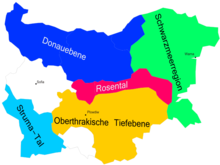Viticulture in Bulgaria
The viticulture in Bulgaria has a long tradition. Bulgaria is one of the world's largest wine producing countries.
Wine-growing regions
Bulgaria can be divided into five wine-growing regions based on the climatic conditions and the grape varieties grown :
- The Danube Plain region in northern Bulgaria. It extends over the central and western parts of the Wallachian Plain , the southern bank of the Danube and the adjacent areas. This region is characterized by its moderate continental climate with hot summers and many hours of sunshine. Mainly nutmeg-Ottonel , Cabernet Sauvignon , Merlot , Chardonnay , Aligoté , Pamid and Gamza are grown.
- The Black Sea region in eastern Bulgaria. The Black Sea region is characterized by a long and mild autumn. These are excellent conditions for sugar formation, which is particularly beneficial for the white wines from the region. In the Black Sea region there are especially Dimiat , Riesling , Muscat-Ottonel , Ugni blanc , Sauvignon blanc , Cabernet Sauvignon, Chardonnay and Gewürztraminer .
- The Rose Valley in Central Bulgaria. The Rosental is located south of the Balkan Mountains . Muscat , Riesling, Rkatsiteli , Cabernet Sauvignon, Misket and Merlot dominate this region .
- The Upper Thracian Plain in southern Bulgaria. In this region there is a moderate continental climate with an even distribution of precipitation over the entire growing season. Here is Mavrud , Merlot, Cabernet Sauvignon, Muscat and Pamid grown.
- The Struma Valley in the southwest. In this area there are almost Mediterranean climatic conditions. The grape varieties grown are: Cabernet Sauvignon, Merlot and the regional Melnik .
history
Viticulture in Bulgaria goes back to the time of the Thracians , who settled today's Bulgaria in the 8th century BC. The Roman occupation brought new winemaking and pressing methods to the Balkan Peninsula. During this time, Thracian wine became famous throughout the Roman Empire.
In the Middle Ages, monks mainly cultivated red wine in what is now Bulgaria. During the Turkish rule, viticulture was of no particular importance, as the Koran forbids Muslims to enjoy wine. However, table grapes were increasingly grown during this period.
At the beginning of the 20th century, phylloxera destroyed a large part of the cultivation area. During the following reconstruction, French grape varieties were introduced alongside the traditional grape varieties. In the decades that followed, wine cooperatives developed based on Western European models. During the socialist era, the state monopoly Vinprom was established in 1947 . To supply the Eastern Bloc, viticulture took on industrial features. In 1990 all wineries were privatized.
Wine economy today
In 2004 Bulgaria produced 1,949,000 hectoliters of wine on an area of 97,000 hectares. 63% of this is red wine, 31% white wine, the remaining 6% dessert wine. Before the collapse of the Eastern bloc, 80% of the total production was exported, today almost half (905,000 hl) is exported. 85% of exports go to six countries: Russia (35%), Poland (23%), Great Britain , Germany , Latvia and Lithuania .
A large part of the vines shows an unfavorable age structure (65% older than 20 years) and is in poor condition. The necessary care takes place above all in the varieties for which only low prices can be achieved, e.g. B. Pamid and Dimyat, do not take place.
In recent years, viticulture has benefited from modernization programs. For example, 5000 hectares of vineyards were replanted as part of the SAPARD program.
Grape variety index:
| variety | proportion of |
|---|---|
| Pamid | 22% |
| Merlot | 11% |
| Cabernet Sauvignon | 10% |
| Rkaziteli | 9% |
| Dimiat | 8th % |
| Siroka Melniska (Melnik) | 4% |
| Misket | 4% |
| Musket Otonell | 3% |
| Chardonnay | 2% |
| Ugni Blanc | 2% |
Web links
- National Chamber of Vine and Wine website - www.bulgarianwines.org
- Bulgaria: The changeful history of viticulture by Rudolf Nickenig published in: Der Deutsche Weinbau , issue 4/2004
- Office International de la Vigne et du Vin (OIV)
- SAPARD program of the EU Weblink
- European Commission - Directorate-General for Agriculture and Rural Development - WINE Economy of the sector (February 2006) Weblink (PDF file; 1.3 MB)
- harper’s supplement bulgaria March 2007 web link ( Memento from March 2, 2008 in the Internet Archive )
